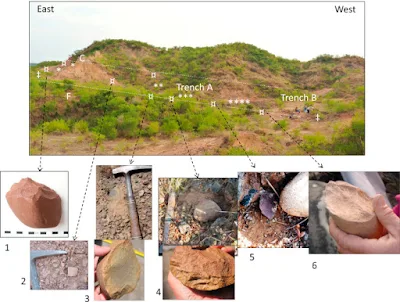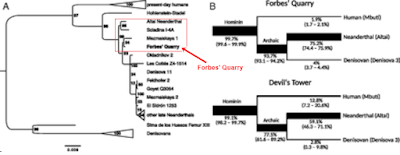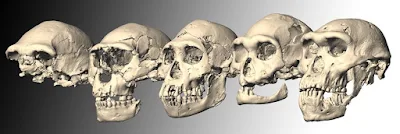A A recent paper by Stephane Peyregne et al., (Nuclear DNA from two early Neandertals reveals 80,000 years of genetic continuity in Europe, Science Advances 26 Jun 2019: Vol. 5, no. 6, eaaw5873
DOI: 10.1126/sciadv.aaw5873) looked into the mitochondrial DNA (mtDNA) of some ancient European remains and compared them to that of modern humans, Neanderthals and Denisovans.
What they found is indeed interesting, and unexpected.
The team sampled the remains of two Neanderthal people, which lived roughly at the same time (some 125,000 years ago), relatively close to each other in Western Europe: a male femur (thigh bone) discovered in the Hohlenstein-Stadel Cave, Germany, back in 1937 -this sample was named HST. They also analyzed a jaw bone belonging to a girl found in 1993 in Scladina, Belgium.
The mtDNA of the Scladina girl and the HST man, both from Western Europe, were most similar to the mtDNA of the Altai Neandertal (from the Altai region in Asia), 3,300 miles (5.300 km) west of Scladina and Hohlenstein-Stadel.
Their mtDNA was quite different from the mtDNA of later European Neanderthals that lived in the same region 80,000 years later.
HST and its unique mtDNA
The HST an carried mtDNA that was very different from that of all other Neanderthals, it had more than 70 mutations that distinguish it from the others' mtDNA. The bone was dated to approximately 124 kya. (62 to 183 kya), but its mtDNA split from that of other humans 270 kya.
The girl's remains are of a similar age: 127 kya (95 to 173 kya) but her mtDNA was more similar to that of an Asian Altai Neanderthal.
In fact both Scladina and the Altai Neanderthal grouped together in a branch of their own, with HST at the root and all other later Neanderthals on a separate branch.
The image below shows the branch that groups the Scladina girl with Atai Neanderthals and the HST Branch (inside the red square). As you can see, they are quite differentiated from that of all the other Neanderthals
and Modern Humans (we are shown on the upper part of the diagram).
MtDNA of Neanderthals, Sima de los Huesos, Denisovan and Modern Humans
The fact that these three older Neanderthals are grouped together (see red square in image above) means that they share a common lineage of mtDNA; they all lived more or less at the same time (some 125 kya) and spanned a wide geographic area from the North Sea to the Altai in Siberia.
All more recent Neanderthals who lived roughly 40,000 years ago (green square in the image above) shared a common ancestor who lived some 97 kya, and belong to a branch that diverges from that of these three older Neanderthals.
These "modern" Neanderthals' mtDNA is derived from that of the "older" group.
The interesting part is that the Denisova Neanderthal (see "Denisova 11" in the image) which lived 90 kya in the Denisova cave in Central Asia, and is a hybrid of Denisovan father and a Neanderthal mother, has mtDNA
which is closer to the more recent Neanderthals of Western Europe than to the Altai Neanderthal that lived in that same Denisova cave! 120,000 years ago.
This means that the ancient mtDNA of Altai Neanderthals was replaced by the "new" mtDNA shared by Denisova 11 and all other modern Neanderthals, so these later western European Neanderthals migrated east into Siberia and repopulated the Altai.
What about the Nuclear DNA?
The team looked into the nuclear or autosomal DNA of both Scladina and HST specimens and compared them with that of other Neanderthals.
They found that from a nuclear DNA point of view HST and Scladina were "more closely related to Vindija than they are to the Altai Neandertal". Vindija is a cave in Northern Croatia.
We see that all Neanderthals, old and recent share a common root for their nuclear DNA, but there are two branches: one with the Altai Neanderthal, and the other with all the other Neanderthals.
So it may be reasonable to suppose that all known Neanderthals (old and recent) share a common origin, and that it split as they migrated into Western Europe (HST and Scladina) and Siberia (Altain Neanderthals), this explains their branching.
Regarding the Atai Neanderthal, (see Prüfer K, Racimo F, Patterson N, et al. The complete genome sequence of a Neanderthal from the Altai Mountains,
Nature. 2014;505(7481):43–49. doi:10.1038/nature12886) it was found to be (see Figure 2b in that paper) on the most diverged and basal branch within Neanderthal's nuclear DNA and therefore furthest away from the Vindjia specimens).
See image below, which I adapted from (here) and Fig. 2 of Peyregne et al.; it depicts the Nuclear DNA branching.
So we can imagine a very early migration of Neanderthals into Siberia (ancestral to Altai Neanderthal) who did not leave descendants.
The Western Neanderthal population (which included HST and Scladina) had settled Europe 125 kya and its descendants later migrated across Eastern Europe, entered Asia and settled in the Altai region
replacing this eastern population in Asia.
The very odd HST mtDNA
The very divergent mtDNA carried by HST split from that of all other Neanderthals some 270,000 years ago. This is far older than expected by the team (they'd estimated less than 150 kya).
And they believe that this is due to the fact that "HST carries some ancestry from a genetically distant population.".
They propose two scenarios:
- "Admixture between Neandertals and ancestors or relatives of modern humans could explain the origin of this later Neandertal mtDNA... If several mtDNAs were introduced into the Neandertal population by
such a putative gene flow, then the deeply divergent mtDNA in HST may represent the remnants of the mitochondrial diversity of this introgressing population... This would imply that this admixture into Neandertals
occurred later than the previously suggested lower boundary of 270 ka ago".
- "An alternative source for the deeply divergent mtDNA in HST could be an isolated Neandertal population, for example, a population that separated from other Neandertals before the glacial period
preceding HST and Scladina (~130 to 190 ka ago...). Such an isolated population may have preserved the mtDNA that was later re-introduced during a warmer period between 115 and 130 ka ago
(the “Eemian” period) when these populations met again and gene flow resumed."
Discussion
I ask: Can we reasonably expect a group to remain in isolation for 15,000 to 75,000 years and maintain their mtDNA without mutations? This "isolated group"notion is identical
to the Beringian Standstill Hypothesis which states that the humans who would people America remained isolated in Beringia for tens of thousands of years.
But the Beringian mutated while the isolated Neanderthals did not! This is weird, same situation and two different outcomes:
The Beringians suffered mutations that gave their descent, the modern Native Americans a distinctive mtDNA that is not found in Asia is said to have arisen during the "standstill": after their ancestors left Asia, but before they dispersed into the Americas.
Yet the isolated ancestors of the Neanderthals retained their original mtDNA without anyn mutations.
So in one case it is mtDNA "stasis" and in another "mutation". You can't have it both ways. One or other or perhaps even both theories are wrong.
In this context, the admixture theory seems reasonable, but why should we have to assume admixture? Let's read it in the paper's words:
"It seems unexpected that HST carries an mtDNA lineage that diverged ~270 ka ago from other mtDNAs, given the recent population split times from the Vindija ancestors and the low levels
of genetic diversity in the nuclear genomes of Neandertals".
In other words, as their nuclear genome is very similar to that of the Vindija Neanderthals, who lived 80 ky later than HST, their mtDNA can't be 270 ky old.
They add:
"An explanation could be related to a replacement of mtDNAs in Neandertals that has been suggested to explain the discrepancy between the mtDNA divergence time (<470 ka ago)
and the population split times based on nuclear DNA (>520 ka ago) between modern humans and Neandertals.
The Sima de los Huesos hominins, and perhaps other early Neandertals, carried mtDNAs that shared a common ancestor with Denisovan mtDNAs more recently than with those of modern humans,
whereas later Neandertals carried mtDNAs that shared a more recent common ancestor with the mtDNAs of modern humans.
Admixture between Neandertals and ancestors or relatives of modern humans could explain the origin of this later Neandertal mtDNA".
We see that once again there is a discrepancy between mtDNA and nuclear DNA divergence dates, you'd expect both to be the same age. In this case it is 470 ky vs. 520 ky.
In a previous post on this subject (Sima de los huesos is now.... closer to Neanderthals than Denisovans!) I gave an explanation for this
conundrum as follows:
The common mtDNA shared by Denisovans and Sima de los Huesos but not the nuclear DNA could be explained as follows:
- A native archaic population lives in Eurasia (descendants of H. erectus?) with its specific autosomal DNA and mtDNA; they are the ancestors of Denisovans and a pre-Sima de los Huesos people.
- A later wave of proto-Neandertal reach Europe, they are more successful and breed with the native women (kill the men and keep the women) of the native pre-Sima de los Huesos stock.
The original archaic mtDNA is preserved in their offspring -since it is transmitted by the mothers to their children-, but the nuclear DNA is now admixed with that of the proto-Neandertals.
After many generations we have a European lineage with mtDNA similar to the original ancient stock (Homo erectus?) and therefore shared with Denisovans, but a nuclear DNA which will be more like
that of Neanderthals which were formed by this admixture.
A similar event must have taken place with the Neanderthals.
Patagonian Monsters -
Cryptozoology, Myths & legends in Patagonia
Copyright 2009-2019 by Austin Whittall ©


































